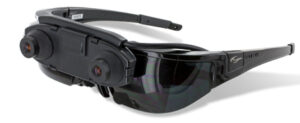Founded in 1997 to build head-mounted displays, Vuzix has spun off its business supplying displays to the military and it is doubling down on the emerging market coming for wearable computing. Soon, the market will tell them who, how, and when people will wear heads-up displays.
Vuzix’ motto is “View the Future,” because they’re selling eye-wear for immersive display, entertainment, and augmented reality. For the most part their glasses are as much like wrap around sunglasses as possible, and they’re reasonably cool looking.
Based in Rochester, New York, Vuzix was originally called Interactive Imaging Systems. It was formed with the acquired assets of Forte Technology, a pioneer in virtual reality. The company originally did most of its business for the military with a goal to pushing their technology to the mainstream when the time was right. The time must be getting right because the company has spun off the high end, ruggedized products engineered and marketed by Vuzix’ TDG (tactical display group) and the company is starting anew to address the mainstream. Meanwhile, the TDG is now doing business as Six15.
Most of Vuzix’s glasses have see-through technology coupled with digital content of some form so that you can do things like watch movies, or check email without closing off the rest of the world. Vuzix says this eliminates the claustrophobic feeling that can happen when you can’t see the what’s going on around you.
The Wrap 1200AR is something else entirely. As an AR tool, the Wrap’s cameras capture the real world and combine that projection with the content being supplied by a computer. The dual displays support 2D and 3D applications. It’s not designed as a walking-around product but more of a sit at your desk and interact with AR apps. At the moment, it’s more of a developer’s tool than a consumer device. And, as a matter of fact, it carries a developer-worthy price tag of $1500. The 1200AR is being sold with a free copy of Autodesk’s MaxReality, an AR content authoring plug-in for 3ds Max. Vuzix says the Wrap 1200AR is compatible with “virtually all leading AR authoring systems” and comes with a VR/AR SDK for developers, which includes demos for stereoscopic 3D video, head tracking, and use of the AR camera data. The company’s website features a short little video to illustrate application ideas for the Wrap 1200AR.

Vuzix is rapidly building products to meet a need the company believes will materialize in a short time. It’s racing to complete development on its Smart Glasses line that are similar to the Google Glass idea. Vuzix took the M100 to CES. It’s a monocular device that includes an integrated head tracker and GPS, and can access applications via Android. It’s clearly being pitched at the same market as Google Glass. The device won a CES Innovation Award at CES 2013. Shortly after the conference, the company announced that it had received patent grants including patents titled “Agile Optical Phased Array Device and Applications” and also “Near Eye Display with On-Axis Symmetry.”
The company is all in on wearable computing. Before the split, the Vuzix made $13.05 million in 2011. They haven’t reported their 2012 income, but it could come in at around $4.5-$5 million if the fourth quarter comes in at around the same rate as previous quarters in 2012. Their timing could be pretty good, Google has said they will have developer models of Google Glass out in 2013 for sale by 2014. Vuzix’s site promises their Smart Glass products are “coming soon.”

Our take
We tried on the wrap around glasses a while back. The company was demonstrating them for entertainment and the idea was that you could adjust your focus to look at the digital content or look through the glasses to the world around. Personally, I found it difficult to use for a movie – though in fairness I didn’t try for long enough to really get used to it. However, I found the sunglasses perfectly usable for AR type applications in which I might want to check out a translation or information screen related to something I was looking at with the glasses.
The question really is, what do you want these things for and how often will you use them? Clearly, the head mounts are not a great idea for driving. In that case we’ll use a heads up display projected on the windshield. (Don’t you have one in your car?) In general, it might not even be that useful while walking around and you honestly will look like a dork until these things can become even more unobtrusive, but personally I can not wait to be able to access information about the world around me as I encounter it. How long does it take to paint the Golden Gate Bridge? Where are the best dumplings in Chinatown? Can I walk to the nearest Trader Joe’s? It’s all coming, and Vuzix has bet everything that it’s coming soon.





